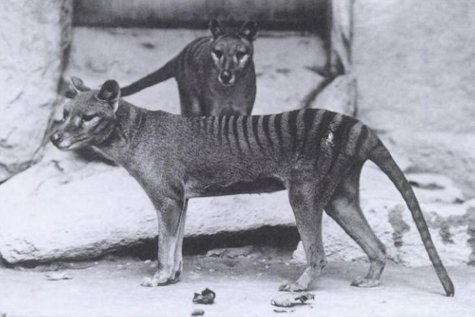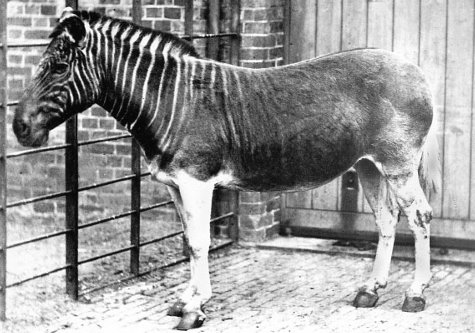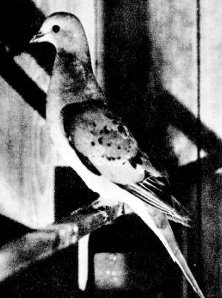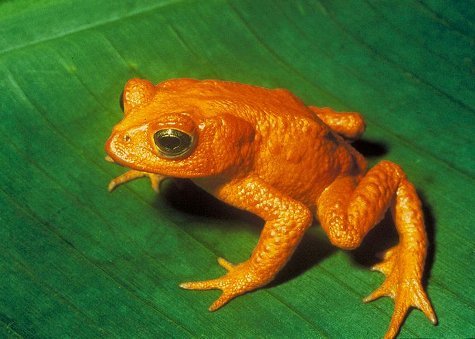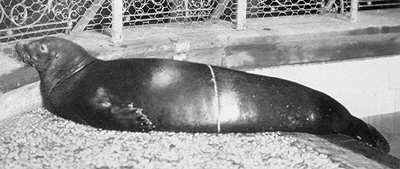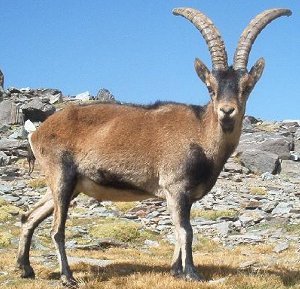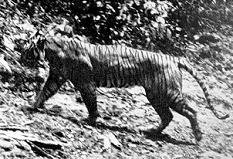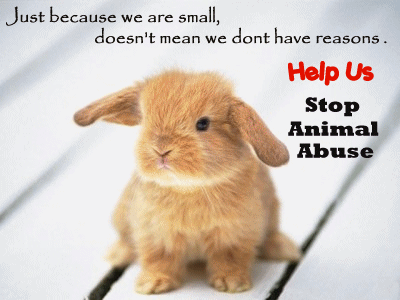It looks like you're using an Ad Blocker.
Please white-list or disable AboveTopSecret.com in your ad-blocking tool.
Thank you.
Some features of ATS will be disabled while you continue to use an ad-blocker.
share:
Tasmanian Tiger
==================================================
Quagga
==================================================
Passenger Pigeon
==================================================
Golden Toad
==================================================
Caribbean Monk Seal
==================================================
Pyrenean Ibex
==================================================
Bubal Hartebeest
==================================================
Javan Tiger
==================================================
Tecopa Pupfish
==================================================
Syrian Wild Ass
==================================================
Baiji River Dolphin
Source
==================================================
Message to ATS: There are thousands of animal species which are on brink of extinction now.
End
The last Tasmanian Tiger, or Thylacine, known to have existed died in the Hobart Zoo, in Tasmania, Australia, on September 7th, 1936. Despite being the last of its kind, the animal (named “Benjamin”) likely died due to neglect after being locked out of its sheltered quarters during extreme weather.
The biggest cause of their extinction in the wild was a massive hunting campaign instituted by the Tasmanian government from 1888 to 1909, justified because the Thylacines were believed to be a threat to sheep and hens. The last known wild Tasmanian Tiger was killed by a farmer named Wilf Batty in 1930, after spotting the animal around his hen house.
==================================================
Quagga
The Quagga was a unique variety of Plains Zebra, marked by having stripes only on the front of its body, with hair color transitioning toward a light brown or tan along its rear and underbelly, until becoming white along its legs. This picture represents the only Quagga ever to have been photographed alive, taken at the London Zoo in 1870.
Its unique hide made the Quagga a target for hunters and poachers, and the last known wild Quagga was probably killed in the late 1870’s. The species went extinct on August 12th, 1883, when the last specimen died at a zoo in Amsterdam, The Netherlands.
==================================================
Passenger Pigeon
Passenger PigeonThe story of the Passenger Pigeon is one of the most tragic extinction stories in modern times. As recently as around 200 years ago they weren’t anywhere near extinction. In fact, they were actually the most common bird in North America, and some reports counted single flocks numbering in the billions.
Colonial hunters happened. The pigeon meat was commercialized and recognized as cheap food, especially for slaves and the poor, which led to a catastrophic hunting campaign on a massive scale. Furthermore, due to the large size of their flocks, the birds were seen as a threat to farmers. In fact, in 1703 the Catholic bishop of Quebec actually excommunicated the entire species.
The last known Passenger Pigeon, named “Martha”, died in captivity on September 1st, 1914, in Cincinnati, Ohio. In 1896, the last flock of 250,000 birds were slaughtered by hunters despite the knowledge that it was the last flock of that size left.
==================================================
Golden Toad
The first recorded account of the Golden Toad was by herpetologist Jay Savage in 1966, and the last sighting of the species was made in 1989. The toad, showcased by its brilliant golden orange colorization, was native to the tropical cloud forests which surround Monteverde, Costa Rica.
==================================================
Caribbean Monk Seal
The Caribbean Monk Seal was the only known seal which was native to the Caribbean Sea and the Gulf of Mexico. It is also the only species of seal to go extinct directly due to human causes. It was officially declared extinct just last year, on June 6th, 2008, although the last recorded account of the species was made at Serranilla Bank between Honduras and Jamaica in 1952.
Their eventual demise, brought on by human hunting, was symbolized during Columbus’ 1494 voyage, when the tiny seals were described as “sea wolves” and 8 were recorded to have been killed and slaughtered for their meat.
==================================================
Pyrenean Ibex
The Pyrenean Ibex has one of the more interesting stories among extinct animals, since it was the first species to ever be brought back into existence via cloning, only to go extinct again just seven minutes after being born due to lung failure. Here at Ecoworldly, we reported on the event, which happened in January 2009.
The last naturally born Pyrenean Ibex died on January 6th, 2000, after being found dead under a fallen tree at the age of 13.
==================================================
Bubal Hartebeest
The Bubal Hartebeest was a magnificent, tough beast which was once domesticated by the ancient Egyptians as a food source and for sacrificial purposes. The creature was even mentioned in the Old Testament.
Although it once roamed throughout Northern Africa and the Middle East, the deep-rooted mythology which surrounded the animal was not enough to save it from European hunters who began hunting them for recreation and meat. The last Bubal Hartebeest was probably a female which died in the Paris Zoo in 1923.
==================================================
Javan Tiger
Javan Tigers are a subspecies of tiger which were limited to the Indonesian island of Java. The last specimen to have been seen was sighted in 1972, although there is evidence from track counts thatthe animal had lingered into the 1980’s. The last track counts to yield evidence of the tigers was held in 1979, when just three tigers were identified.
The leading cause of their extinction was agricultural encroachment and habitat loss, which continues to be a serious concern in Java.
==================================================
Tecopa Pupfish
The Tecopa Pupfish has the unfortunate distinction of being the first species to be declared extinct under the Endangered Species Act of 1973. The official de-listing ofthe animal came in 1981.
The fish were first discovered in the Tecopa Hot Springs in California in 1942, and their decline followed shortly thereafter, as the Hot Springs were canalized and replaced with bathhouses. The final nail in the coffin came when hotels and trailer parks were built nearby to allow for more comfortable recreation for tourists.
==================================================
Syrian Wild Ass
The Syrian Wild Ass was likely extinct when the last known captive animal died at the Schönbrunn Zoo in Vienna, Austria, in 1928. It once had a wide range throughout Mesopotamia, where reports were common of large herds which used to roam wildly in the mountains and desert steppes of the Middle East.
Although already threatened beforehand, it is said that the Syrian Wild Ass completely collapsed during World War I, when their habitat was overrun with heavily armed Turkish and British troops. One account remarked that “it could not resist the power of the modern guns in the hands of the Anazeh and Shammar nomads, and its speed, great as it may have been, was not sufficient always to escape from the velocity ofthe modern motor car which more and more is replacing the Old Testament Camel-Caravan.”
==================================================
Baiji River Dolphin
The inevitable appears to have arrived for the Baiji River Dolphin, a peaceful, majestic dolphin which had inhabited China’s Yangtze River for at least the last 20 million years. The dolphin was declared functionally extinct after an expedition late in 2006 failed to record a single individual after an extensive search ofthe animal’s entire range.
Although unconfirmed sightings have come out since then, it’s unlikely that any living individuals, should they still exist, would be able find each other and breed. This tragic demise makes the Baiji Dolphin the first recorded extinction of a cetacean in modern times.
The population had been declining rapidly in recent decades since the rise of Chinese industrialization, which has utilized the Yangtze River as one of its primary arteries. The river is now one of the worst polluted major waterways in the world, being heavily relied upon for transportation and hydroelectricity. Roughly 12% of the world’s human population lives and works within the river’s catchment zone.
Source
==================================================
Message to ATS: There are thousands of animal species which are on brink of extinction now.
End
A great thread December Rain, S&F for you and your effort to raise awareness.
It makes me sad thinking of those wonderful animals that are no more, made extinct by human intervention, and we continue to do harm to our sensible enviroment, we don't learn from our mistakes, mistakes like the complete extinction of the Tasmanian Tiger...
It makes me sad thinking of those wonderful animals that are no more, made extinct by human intervention, and we continue to do harm to our sensible enviroment, we don't learn from our mistakes, mistakes like the complete extinction of the Tasmanian Tiger...
reply to post by Clairaudience
Thank you for your kind words and support. I thought people need to know more about this. Even this was new for me.
Thank you for your kind words and support. I thought people need to know more about this. Even this was new for me.
Very strange about the Quagga
I remember as a kid, riding the little train that encompasses the Tulsa Zoo, and seeing this animal
I have tried to explain it since, but no one knows what Im talking about
THIS IS THE ANIMAL I SAW
I remember the conductor dude talking about this animal being made of the spare parts God had left over, and there weren't many left...this was in the early to mid 1980's
I remember as a kid, riding the little train that encompasses the Tulsa Zoo, and seeing this animal
I have tried to explain it since, but no one knows what Im talking about
THIS IS THE ANIMAL I SAW
I remember the conductor dude talking about this animal being made of the spare parts God had left over, and there weren't many left...this was in the early to mid 1980's
reply to post by daddymax
You were lucky to even see it, imagine our future generation without ever knowing or seeing them except in snapshots. It's terribly sad, indeed.
You were lucky to even see it, imagine our future generation without ever knowing or seeing them except in snapshots. It's terribly sad, indeed.
By the time our kids are grown up we will have killed off hundreds more animals to add to the photo album of animals that no longer exist. In my life
time I imagine I'll see plenty more extinct in the wild. We have a superiority complex as a species I find unbecoming.
Cheers
Cheers
Good thread but the most famous of these "extinct" animals has been left off of the list!
The Celocampth.
The Celocampth.
EDIT: Wrong thread.
[edit on 25-1-2010 by Jinni]
[edit on 25-1-2010 by Jinni]
[edit on 25-1-2010 by Jinni]
[edit on 25-1-2010 by Jinni]
reply to post by Jinni
the Coelacanth doesn't belong on the list because it isn't extinct. All the other others, no living examples are known to exist
the Coelacanth doesn't belong on the list because it isn't extinct. All the other others, no living examples are known to exist
What a beautiful thread!
This is the most enjoyment i have had from an ATS thread in about 2 months
Stunning animals. Clearly shows the problomatic nature of the human race and how it has caused destruction to wildlife and nature and not just eachother.
S 'n' F x
This is the most enjoyment i have had from an ATS thread in about 2 months
Stunning animals. Clearly shows the problomatic nature of the human race and how it has caused destruction to wildlife and nature and not just eachother.
S 'n' F x
Ooh! look at the interesting animals! Thank you for sharing this awesome information! you learn something new everyday...
very interesting stuff, bless the lot of 'em for putting up with us...
I kind of assumed from the title that these we're going to be photos of animals thought to be extinct but I guess we need to do more, for example
"co2? *** co2 mate, what about the wildlife and the plants? they are all DYING MATE."
@gordon brown/obama. not that that would get their attention, there like goldfish.
I kind of assumed from the title that these we're going to be photos of animals thought to be extinct but I guess we need to do more, for example
"co2? *** co2 mate, what about the wildlife and the plants? they are all DYING MATE."
@gordon brown/obama. not that that would get their attention, there like goldfish.
Yeah, humans are evil. We are killing off animal species. We are the only thing to cause animal extinction on earth except for; volcanos, asteroids,
tidal waves, drought, flood, ice age, and the end of ice ages.
But I guess animal rights wackos would also say that all of those things are our fault as well. What we really need to do is kill millions of people so we can reduce the amount of food we need, so we don't take their habitat.
We then need to stop all production and become nomads again.
I do agree that we need to take care of the animal kingdom to the best of my ability. But, I would kill every animal other than those we depend on for our survival if it meant I could save 1 human life.
Hunt eat meat and be merry for tomorrow some nut may make it illegal!
But the post is very interesting, I am sorry they are gone, but I am also sorry the dinosaurs are gone as well
But I guess animal rights wackos would also say that all of those things are our fault as well. What we really need to do is kill millions of people so we can reduce the amount of food we need, so we don't take their habitat.
We then need to stop all production and become nomads again.
I do agree that we need to take care of the animal kingdom to the best of my ability. But, I would kill every animal other than those we depend on for our survival if it meant I could save 1 human life.
Hunt eat meat and be merry for tomorrow some nut may make it illegal!
But the post is very interesting, I am sorry they are gone, but I am also sorry the dinosaurs are gone as well
reply to post by December_Rain
something tells me your a member of PETA or aspire to be one. id steer clear of them if i was you.
something tells me your a member of PETA or aspire to be one. id steer clear of them if i was you.
reply to post by KKinsane2009
Plants breath CO2. If excess CO2 is introduced into a greenhouse, guess what, faster growing and healthier plants.
AL GORE IS A LIAR.
I can not believe the global warming, we are destroying the planet with CO2 crap.
Water vapor in the atmospher will raise temps higher than CO2 in the air.
AL GORE NEEDS TO BE ARRESTED FOR CREATING A PUBLIC PANIC. WHAT HE DID IS SIMILAR TO YELLING BOMB IN A CROWDED STADIUM WHEN THERE IS NO BOMB.
[edit on 25-1-2010 by russ212]
Plants breath CO2. If excess CO2 is introduced into a greenhouse, guess what, faster growing and healthier plants.
AL GORE IS A LIAR.
I can not believe the global warming, we are destroying the planet with CO2 crap.
Water vapor in the atmospher will raise temps higher than CO2 in the air.
AL GORE NEEDS TO BE ARRESTED FOR CREATING A PUBLIC PANIC. WHAT HE DID IS SIMILAR TO YELLING BOMB IN A CROWDED STADIUM WHEN THERE IS NO BOMB.
[edit on 25-1-2010 by russ212]
reply to post by russ212
The dinosaurs became extinct due to natural things.
Dodo's, for example, didn't, just as the species mentioned above.
The dinosaurs became extinct due to natural things.
Dodo's, for example, didn't, just as the species mentioned above.
reply to post by -Thom-
I know that, I was being sarcastic. Do you know what sarcasam is?
Actually rereading my post, I never said that we caused the extinction of the dinosaurs, I just said I am sorry they are gone, and I am. I would have loved to see one.
[edit on 25-1-2010 by russ212]
I know that, I was being sarcastic. Do you know what sarcasam is?
Actually rereading my post, I never said that we caused the extinction of the dinosaurs, I just said I am sorry they are gone, and I am. I would have loved to see one.
[edit on 25-1-2010 by russ212]
reply to post by russ212
It doesn't work like that and you know it.
That is like saying we shouldn't be upset that our neighbors house burns down when started by an arsonist because they can burn down by natural causes as well.
Or that we should just go ahead and burn an entire neighborhood down in California just in case it could be burned down by wildfire.
Nature has a way of destroying but it has also worked out a way of regenerating as well. When yellowstone burned down decades ago, it ended up encouraging new species to thrive. That could only thrive over those conditions.
Hawaii destorys, but an island is constantly also being created.
Floods may kill animals, but it also forces them to travel farther leading to them finding new habitiat, and it leaves fertile soil to grow better plants.
Humans destroy, destroy entirely, and then destroy some more, without any benefit to nature whatsoever.
Dinosaurs became extinct, but all life wasn't wiped out. About 80% was. But there are STILL creatures alive today who came from those time periods. Then the extinction of the reptiles led to the rise of the mammals.
But when you just eliminate everything and not let nature takes it course, what happens?
It doesn't work like that and you know it.
That is like saying we shouldn't be upset that our neighbors house burns down when started by an arsonist because they can burn down by natural causes as well.
Or that we should just go ahead and burn an entire neighborhood down in California just in case it could be burned down by wildfire.
Nature has a way of destroying but it has also worked out a way of regenerating as well. When yellowstone burned down decades ago, it ended up encouraging new species to thrive. That could only thrive over those conditions.
Hawaii destorys, but an island is constantly also being created.
Floods may kill animals, but it also forces them to travel farther leading to them finding new habitiat, and it leaves fertile soil to grow better plants.
Humans destroy, destroy entirely, and then destroy some more, without any benefit to nature whatsoever.
Dinosaurs became extinct, but all life wasn't wiped out. About 80% was. But there are STILL creatures alive today who came from those time periods. Then the extinction of the reptiles led to the rise of the mammals.
But when you just eliminate everything and not let nature takes it course, what happens?
reply to post by December_Rain
For some reason I can't see the pic of the Wild Ass but the rest of the pics are very good. I guess even through the brink of extinction animals have what it takes to survive the most gruesome of environments. $&F for showing the error of our ways and bringing awareness to such rare critters.
For some reason I can't see the pic of the Wild Ass but the rest of the pics are very good. I guess even through the brink of extinction animals have what it takes to survive the most gruesome of environments. $&F for showing the error of our ways and bringing awareness to such rare critters.
reply to post by December_Rain
Edit: God damn it! double post, my bad.
[edit on 25-1-2010 by Stop-loss!]
Edit: God damn it! double post, my bad.
[edit on 25-1-2010 by Stop-loss!]
new topics
-
Traveling the world with no passport
Social Issues and Civil Unrest: 2 hours ago -
Happy Thanksgiving to ATS
General Chit Chat: 6 hours ago
top topics
-
Mind Blowing Cave under someones land
Fragile Earth: 16 hours ago, 17 flags -
The Party of Peace - Trump Cabinet Picks Targeted with Death Threats
US Political Madness: 17 hours ago, 15 flags -
Simple Thanksgiving
Food and Cooking: 12 hours ago, 15 flags -
Trump Presidential Transition Team will not use GSA or Government entities to come to DC
US Political Madness: 16 hours ago, 14 flags -
Trump could make a peaceful American Revolution
US Political Madness: 16 hours ago, 14 flags -
Happy Thanksgiving to ATS
General Chit Chat: 6 hours ago, 6 flags -
Traveling the world with no passport
Social Issues and Civil Unrest: 2 hours ago, 5 flags
active topics
-
Simple Thanksgiving
Food and Cooking • 28 • : yeahright -
Petition Calling for General Election at 564,016 and rising Fast
Political Issues • 107 • : gortex -
Traveling the world with no passport
Social Issues and Civil Unrest • 2 • : AdultMaleHumanUK -
I thought Trump was the existential threat?
World War Three • 116 • : andy06shake -
Well, here we go red lines crossed Biden gives the go ahead to use long range missiles
World War Three • 402 • : andy06shake -
Mind Blowing Cave under someones land
Fragile Earth • 18 • : Flyingclaydisk -
D.B. Cooper mystery may be solved
General Conspiracies • 22 • : andy06shake -
Happy Thanksgiving to ATS
General Chit Chat • 4 • : VariedcodeSole -
Post A Funny (T&C Friendly) Pic Part IV: The LOL awakens!
General Chit Chat • 7840 • : GENERAL EYES -
Trump Presidential Transition Team will not use GSA or Government entities to come to DC
US Political Madness • 14 • : WeMustCare

